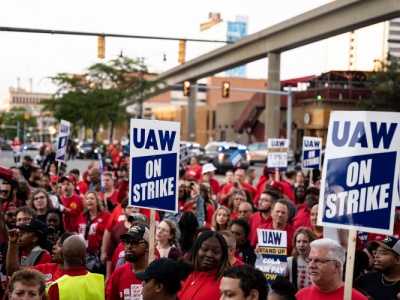In mid-September, the United Auto Workers (UAW), which represents nearly 150,000 auto workers, began targeted strikes at certain factories and warehouses around the country run by Ford, GM, and Stellantis NV (formerly Chrysler), the “Big Three” automakers. Although auto strikes against the Big Three aren’t unprecedented, this recent strike had two novel aspects. First, it was a partial strike that started at only three plants, idling just over 13,000 workers. The UAW gradually expanded the strike to other plants over time to ratchet up the pressure. Second, the strikers were employed by each of the Big Three instead of one automaker at a time being targeted. After six contentious weeks, the UAW and the Big Three reached a deal, and employees went back to work. What are the details, and what can other employers learn from this strike? Read on to find out.
What’s the Deal?
The UAW struck deals with all three companies to put an end to its unprecedented strike, and the publicly reported terms of the agreements were extremely favorable to the union.
When contract talks began in July, the UAW initially sought aggressive 40% pay increases over four years and a 32-hour workweek, citing inflation and record company profits as justification. When the Big Three didn’t meet those and other demands at the bargaining table, the UAW called for a strike. As a result, the companies have seen combined losses of about $2.9 billion, according to Bloomberg Law.
Most notably, the deal includes a 25% wage increase through April 2028 and the restoration of cost-of-living allowances that had been lost in past contract negotiations. At GM plants, for example, the UAW stated that the wage increases will cumulatively raise the top wage by 33% compounded with estimated cost-of-living adjustments to over $42 an hour, and the starting wage will increase by 70% compounded with estimated cost-of-living adjustments to over $30 an hour.
Although the UAW didn’t achieve its goal of a return to defined-benefit pensions, the agreement does require the Big Three to boost contributions to 401(k) retirement savings plans—a much more palatable option for the companies.
The settlements also addressed the UAW’s concern about the rise of electric vehicles and their impact on the UAW and its workers. Electric vehicles require substantially less labor—and therefore, fewer employees—than traditional internal combustion engines.
The union didn’t get the companies to agree to allow it to organize all of the $28 billion worth of battery plants the automakers are building in the United States, but it did win transfer rights for UAW-represented workers into some plants. Also, the companies agreed to provide various pathways for future electric vehicles workers to come under the UAW umbrella.
While the costs of the agreement are expected to cut into the Big Three automakers’ profit margins, Ford says it expects to find efficiencies to offset the higher labor costs. GM and Stellantis will likely do the same, thereby softening the blow the agreement might have otherwise had on the companies.
What Should Employers Learn from the Strikes and Deal?
The UAW’s aggressiveness reflects a spike in labor activism as American workers, spurred by tight labor markets and affected by inflation, press for better pay and benefits. Before the deals were struck, the UAW had already indicated its intention to use what it hoped would be a good contract settlement with the Big Three to try to organize workers at other, nonunion automakers. With such contract settlements, it wouldn’t be surprising to see organizing efforts at nonunion automakers, such as Tesla and Toyota, ramp up.
Non-automaker employers should also heed a warning about increased labor activism. President Joe Biden’s National Labor Relations Board (NLRB) has implemented a number of labor-friendly rules over the last several years, making it much easier for employees to unionize workplaces.
According to Bloomberg Law’s NLRB Election Statistics, Year-End 2022 Report, there were more union elections in 2022 than in previous years, and unions were winning most of them. Specifically, there were 1,573 elections in 2022—up from 1,021 in 2021. Unions won 1,196 of those elections—an increase from 764 wins in 2021. Notably, unions won 76% of the 2022 elections, marking the fifth straight year the union win rate was higher than 70%.
Bloomberg hasn’t released its 2023 statistics, but if 2022 is a reflection of how 2023 may have gone for employers, it’s clear aggressive labor tactics are on the rise.
Meaghan Murphy is an associate at the firm Skoler, Abbott & Presser, P.C., in Springfield, Massachusetts, and can be reached at mmurphy@skoler-abbott.com.

